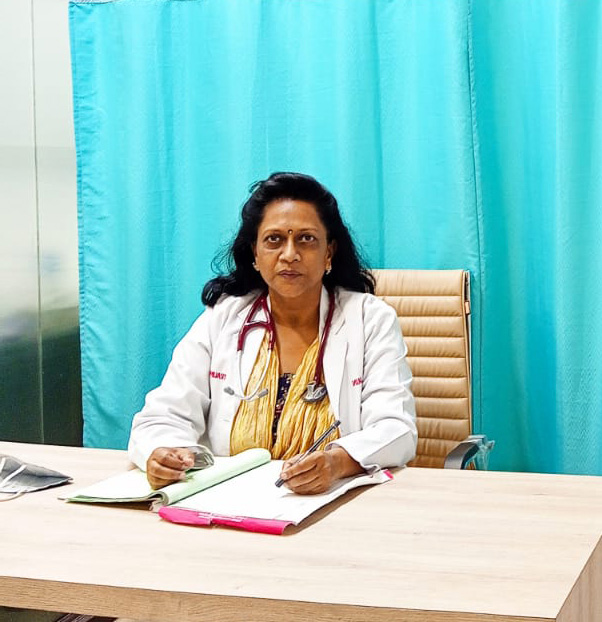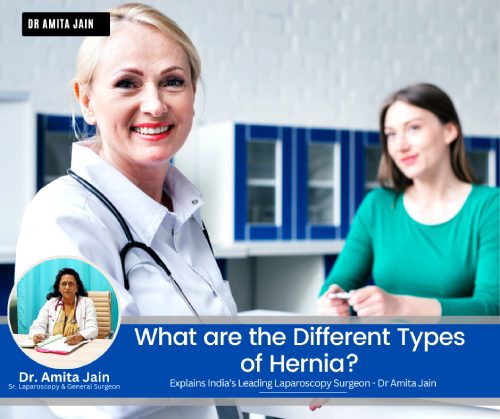India’s leading laparoscopic surgeon and expert hernia surgeon, Dr Amita Jain, Explains Everything You Need to Know about Hernia
A hernia happens when an organ or fatty tissue pushes through a weak spot or opening in the surrounding muscle or connective tissue. It is a common medical condition that can affect different parts of the body. Understanding the various types of hernias is essential for accurate diagnosis, appropriate treatment, and effective prevention.
In this article, Dr Amita Jain one of the best hernia repair surgeons in Delhi in the field of laparoscopic surgery, shares comprehensive information about the most common types of hernias.
Inguinal hernias are the most common type, representing nearly 70% of all hernias. They occur when the intestines or bladder push through a weak spot in the abdominal wall or inguinal canal, located in the groin area. While more prevalent in men due to inherent weakness in the inguinal canal, women, particularly those who are pregnant or have given birth, can also be affected. Symptoms include a visible bulge in the groin, pain or discomfort, and a dragging sensation.
Femoral Hernia
Similar to an inguinal hernia, a femoral hernia also appears in the groin region. However, it develops slightly lower, just below the inguinal canal, in the upper thigh area. This type of hernia is more common in women, particularly those who are pregnant or overweight.
Femoral hernias are often smaller than inguinal hernias but can lead to complications if left untreated. Symptoms include a bulge in the groin or thigh, pain or discomfort, and a feeling of fullness.
Umbilical hernias happen when a part of the intestine or fatty tissue protrudes through the abdominal wall near the belly button. This type of hernia is commonly observed in infants, particularly premature babies, due to the natural weakness in the area where the umbilical cord passes through the abdominal wall.
In most cases, infant umbilical hernias resolve on their own by the age of two without any intervention. However, adults can develop umbilical hernias due to factors like obesity, pregnancy, or previous abdominal surgeries. Surgical treatment may be necessary if the hernia persists or causes discomfort.
Hiatal Hernia
Unlike the earlier types, hiatal hernias occur in the upper part of the stomach, where it bulges up into the chest through an opening in the diaphragm called the hiatus. Hiatal hernias are categorized into two types: sliding and paraesophageal hernias. Sliding hernias are more common and happen when the stomach and esophagus slide up and down through the hiatus.
Paraesophageal hernias, on the other hand, occur when a portion of the stomach pushes through the hiatus alongside the esophagus, potentially leading to complications like gastric strangulation or volvulus. Symptoms include heartburn, chest pain, difficulty swallowing, and regurgitation.
An incisional hernia forms at the site of a previous surgical incision. It happens when the intestines or abdominal tissue push through the weakened scar tissue from previous surgery. This type of hernia is more common in individuals who have undergone abdominal surgery in the past, and factors such as obesity, improper wound healing, or excessive strain can increase the risk of its development. Symptoms include a bulge near or at the site of the surgical incision, pain or discomfort, and a feeling of pressure.
Ventral Hernia
Ventral hernias are similar to incisional hernias but can happen in areas of the abdominal wall that have not been previously operated on. They typically appear as bulges or lumps and can occur due to weak spots or defects in the abdominal wall caused by conditions such as obesity, pregnancy, or heavy lifting. Symptoms include a visible bulge, pain or discomfort, and a feeling of fullness or pressure.
Obturator Hernia
Obturator hernias are rare and occur when a part of the intestine pushes through an opening in the pelvic bone called the obturator foramen. This type of hernia primarily affects older women, especially those who have had multiple pregnancies.
Obturator hernias can be challenging to diagnose because their symptoms can be nonspecific. Common signs include groin pain, thigh pain, nausea, and vomiting. Due to their rarity and difficulty in diagnosis, obturator hernias often require surgical intervention.
Epigastric Hernia
Epigastric hernias occur in the epigastric region, which is the upper central part of the abdomen between the navel and the lower part of the ribcage. These hernias form when fatty tissue pushes through a weak spot in the abdominal wall, typically between the belly button and the sternum.
Epigastric hernias are more common in men and can be caused by factors such as obesity, heavy lifting, or pregnancy. Most epigastric hernias are small and asymptomatic, but larger hernias may cause pain or discomfort. Surgical repair is often recommended to prevent complications.
Spigelian Hernia
Spigelian hernias are relatively rare and occur along the edge of the rectus abdominis muscle, which runs vertically along the front of the abdomen. These hernias develop when the intestines or other abdominal tissue protrudes through a weakness in the spigelian fascia, a layer of connective tissue.
Spigelian hernias are more common in middle-aged or older individuals and can be caused by factors like obesity, previous surgeries, or congenital weaknesses. Symptoms include localized pain, a visible bulge, and discomfort when coughing or straining. Surgical repair is typically necessary to prevent complications.

Dr Amita Jain is a surgeon with the highest degree of professional competence, precision and surgical craftsmanship. Performed all complicated general surgery procedures with in depth knowledge of invasive and few minimal invasive and onco surgical techniques. Underwent special training in trauma, executed various trauma-related complex life-saving neurosurgical procedures, reconstructed injured mangled limbs and performed vascular and reconstructive procedures with critical care.
Dr Amita Jain holds 28 plus years of rich experience in Trauma and General Laparoscopic Surgeries (including Gallbladder stone removal, appendix removal, hernia repair surgery, piles and fissure surgeries). She was the Professor Surgery of at the Army College of Medical Sciences and Base Hospital Delhi Cantt. In 1994 she was commissioned as Surgeon under the United Nations Mission in Congo. From 2020 to 2022, she worked with Bansals Hospital. Currently, Dr Amita Jain is the Senior Consultant, (Speciality: General and Laparoscopic Surgeon) at Artemis Lite Hospital, New Delhi and Sr. General and Laparoscopic Surgeon at Rainbow Children Hospitals, Malviya Nagar, Delhi.

